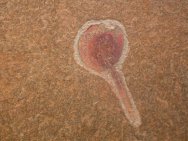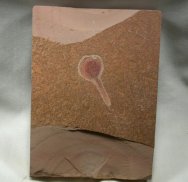Choia
utahensis
Phylum Porifera,
Class Demospongia, Subclass Ceractinomorpha, Order Monaxida, Family Choiidae,
Genus Choia
Geological
Time: Early/Middle Cambrian (~520 million years ago)
Size (25.4mm=1
inch): 40 mm long by 16 mm across on a 120 mm by 85 mm matrix
Fossil Site:
Marjum Formation, House Range, Millard County, Utah
Code: CB028
Price: $85
- sold
|  Description:
This plate contains a sponge of the Genus Choia from the Cambrian
Explosion strata of the Marjum Formation in Utah. Genus Choia are
members of Class Desmospongia, Family Choiidae. Choia lived on the
seafloor unattached and filtered food particles from the water.
Choia are very rare in the Burgess Shale, and not very common in
Cambrian strata of Utah as well. Description:
This plate contains a sponge of the Genus Choia from the Cambrian
Explosion strata of the Marjum Formation in Utah. Genus Choia are
members of Class Desmospongia, Family Choiidae. Choia lived on the
seafloor unattached and filtered food particles from the water.
Choia are very rare in the Burgess Shale, and not very common in
Cambrian strata of Utah as well.
Sponge
fossils from the Cambrian Explosion are found in various Cambrian
sites in North America, most notably the Burgess Shale of Canada,
and the Cambrian strata of Utah, like this specimen. Many sponges
are also described from the Chengjiang biota of China. Sponges are
believed to have undergone repeated radiations in the Phanerozoic,
and probably attained their largest diversity in the Cretaceous.
Rigby, J.K. (1983). Sponges of the Middle Cambrian
Marjum Limestone from the House Range and Drum Mountains of western
Millard County, Utah. Journal of Paleontology 57, 240-270.
|
|



